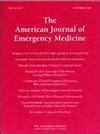纽约市学生心理健康相关儿科急诊就诊趋势
IF 2.2
3区 医学
Q1 EMERGENCY MEDICINE
引用次数: 0
摘要
背景和目的最近的研究强调了儿童精神健康障碍的增加,并因COVID-19而加剧。本研究调查了纽约市公立学校学生在大流行期间与精神健康相关的急诊就诊情况的变化。方法采用logistic回归分析学生因心理健康问题就诊的急诊科概率的变化,作为次要结局,我们分析了与心理健康相关的就诊与其他就诊之间当日出院率的差异。为了进行分析,我们使用纽约市学生人口健康登记处将公立学校学生的记录与急诊科就诊数据联系起来。结果在2020年3月之前,与心理健康相关的每月平均就诊概率没有明显的线性趋势。从2020年3月到2021年6月,除男生小学生外,所有群体的学生人数都有所增加。与大流行前(0.103 (CI =[0.103, 0.104])相比,女性初高中学生的增幅最大(0.031 (CI =[0.027, 0.034]))。2021年6月之后,除了初高中女生外,所有人群的概率都较低,她们的概率比大流行期间高0.009 (CI =[0.007, 0.011])。与大流行前和非精神健康相关就诊相比,大流行期间精神健康相关就诊的同日出院概率降低了0.043 (CI =[0.029, 0.057])。结论2019冠状病毒病(COVID-19)大流行与心理健康相关的急诊科就诊人数和住院时间显著增加有关,尤其是女性初高中学生。本文章由计算机程序翻译,如有差异,请以英文原文为准。
Trends in mental health-related pediatric emergency visits among New York City students
Background and objective
Recent studies highlight an increase in pediatric mental health disorders, amplified by COVID-19. This study examines changes in mental health-related emergency department visits among New York City public school students across the pandemic timeline.
Methods
We employed logistic regression to examine changes in the probability of a student's emergency department visit being mental health-related, and as a secondary outcome, we analyzed the difference in same-day discharge rates between mental health-related visits and other visits. For this analysis, we used the New York City Student Population Health Registry to link public school students' records to emergency department visit data.
Results
No significant linear trends were observed in the average monthly probability of a mental health-related visit before March 2020. From March 2020 through June 2021 there was an increase for all groups except male elementary school students. Female middle and high school students experienced the largest increase (0.031 (CI = [0.027, 0.034])) compared to pre-pandemic (0.103 (CI = [0.103, 0.104])). Post-June 2021, all groups experienced a lower probability except for female middle and high school students, who had a 0.009 (CI = [0.007, 0.011]) higher probability than during the pandemic.
Compared to the pre-pandemic period and non-mental health-related visits, a 0.043 (CI = [0.029, 0.057]) lower probability of same-day discharge was observed for mental health-related visits during the pandemic period.
Conclusions
The COVID-19 pandemic correlated with a significant increase in mental health-related emergency department visits and longer stays, particularly among female middle and high school students.
求助全文
通过发布文献求助,成功后即可免费获取论文全文。
去求助
来源期刊
CiteScore
6.00
自引率
5.60%
发文量
730
审稿时长
42 days
期刊介绍:
A distinctive blend of practicality and scholarliness makes the American Journal of Emergency Medicine a key source for information on emergency medical care. Covering all activities concerned with emergency medicine, it is the journal to turn to for information to help increase the ability to understand, recognize and treat emergency conditions. Issues contain clinical articles, case reports, review articles, editorials, international notes, book reviews and more.

 求助内容:
求助内容: 应助结果提醒方式:
应助结果提醒方式:


